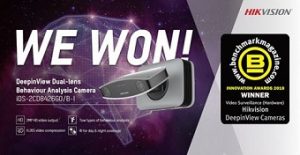
Hikvision has won the Video Surveillance Hardware category in the Benchmark Innovation Awards 2018. The winning Hikvision product was the iDS-2CD8426G0/B-I Deep-in-View dual-lens behaviour analysis camera, which uses cutting-edge deep learning algorithms to analyse human movement for improved safety inside buildings.
The 2018 Video Surveillance Hardware category was strongly contested, with Hikvision competing against four other providers for the title. Gary Harmer, Sales Director for Hikvision UK & Ireland says, “Innovation is at the heart of our business, driven by our extensive research and development. We’re thrilled that Benchmark recognises how the innovative features we deliver with the iDS-2CD8426G0/B-I make a real difference to the safety of our end customers.”
The iDS-2CD8426G0/B-I provides a broad range of cutting-edge features that are not found in typical indoor surveillance systems. Instead of just detecting moving targets, it uses deep learning, stereo imaging algorithms and high speed GPU processing to analyse human body movements. As a result, it can be used to identify a potential human threat or a personal safety issue in real time. The iDS-2CD8426G0/B-I is part of the broader Hikvision Deep-in-View series of cameras, which is designed to boost surveillance system performance across a range of security and management applications.
The Hikvision Deep-in-View series cameras offer features such as, human body detection, which can detect human bodies while filtering out other movements, in order to reduce false alarms; facial recognition, which uses facial image modelling and similarity calculation to alert system operators to the presence of persons of interest; people counting, which uses video analytics to track the number of people who enter and exit a particular area, enabling businesses to improve their profitability and site management; illegal parking detection, the system user is able to set illegal parking zone or the maximum parking time, as long as the vehicle enters the zone, or its parking time surpass the limit, the camera is triggered to collect the evidence; and queue detection, the camera is capable of providing real time alerts and historic information post event on queue waiting time, queue density, etc











